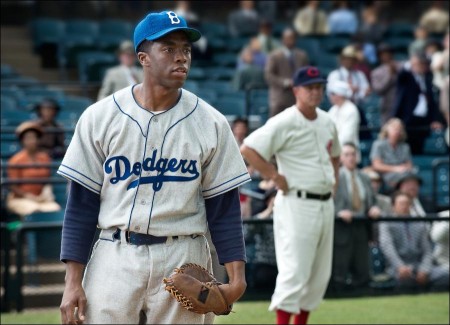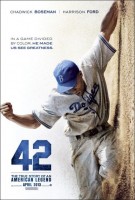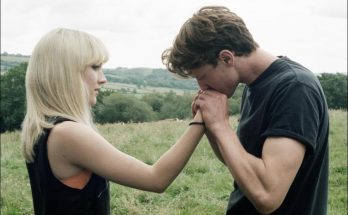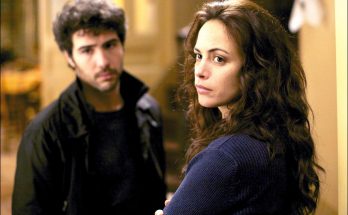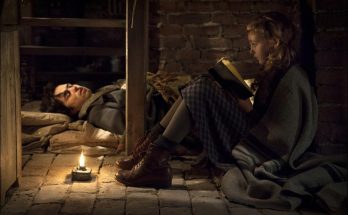Taglines: In a game divided by color, he made us see greatness.
Hero is a word we hear in sports, but heroism is not always about achievements on the field of play. “42″ tells the story of two men—the great Jackie Robinson and Brooklyn Dodgers GM Branch Rickey—whose brave stand against prejudice forever changed the world by changing game of baseball.
In 1946, Branch Rickey (Harrison Ford) put himself at the forefront of history when he signed Jackie Robinson to the team, breaking Major League Baseball’s infamous color line. But the deal also put both Robinson and Rickey in the firing line of the public, the press and even other players.
Facing unabashed racism from every side, Robinson was forced to demonstrate tremendous courage and restraint by not reacting in kind, knowing that any incident could destroy his and Rickey’s hopes. Instead, Number 42 let his talent on the field do the talking—ultimately winning over fans and his teammates, silencing his critics, and paving the way for others to follow.
About the Production (2013)
On April 15, 1947, Jackie Robinson emerged from the tunnel at Ebbets Field in a Brooklyn Dodgers’ uniform bearing the number 42. In that instant, he broke Major League Baseball’s infamous color line. Simply put, that is the extent of what most people know about him in the context of history. However, few today can fully comprehend what that meant in the context of human experience. And the whole of what he achieved was anything but simple.
Brian Helgeland, the writer and director of “42,” reveals that he, like others, was unaware of the level of opposition and overt bigotry Robinson faced as the first African American to play for any major league team. “I thought I knew a lot about Jackie Robinson, but when I began researching the story, I realized I knew very little about that time and what he actually went through. I wanted to make a film that was entertaining but also one that shows what a big breakthrough it was then and how it still resonates today.”
Producer Thomas Tull, a self-described baseball fanatic, offers, “I went to the Baseball Hall of Fame when I was seven years old, which is when I first learned about Jackie Robinson, and his story stayed with me. It touched me and made me wonder what it was like for him because it’s hard for me to fathom what he endured, both as a baseball player and as a man. It really is a classic hero’s journey—someone who has unbelievable odds stacked against him and has the fortitude to overcome those odds and effect great change. When he broke the color line, it marked a turning point, not only in baseball but in history. In that way, it is a moment that transcends sports.”
Chadwick Boseman, who stars as the baseball legend, agrees. “Once you know the full scope of what he did—on the baseball field and in his later work in the Civil Rights movement—you realize that his contribution to society was tremendous, and not just in the sports world. He paved the way for people in every field, so I feel a personal connection to him because I am literally standing on his shoulders right now.”
In the racial climate of 1940s America, it arguably took as much courage to be the man who opened the door to integrating Major League Baseball as it did to be the man who walked through it. It was Brooklyn Dodgers President and General Manager Branch Rickey, who—despite vehement opposition from the league, the public and his own players—signed Jackie Robinson to his team. “Branch Rickey is a great, albeit forgotten, figure,” says Helgeland. “Historians and those in baseball know who he was, but the average person has no idea. He’d given his life to the game and thought very deeply about how to improve it. When he was 65 and could have just rested on his laurels, he bravely decided to put it all on the line and be at the forefront of integrating baseball.”
Harrison Ford, who portrays the visionary baseball executive, states, “It’s an incredible story about a critical step that was taken in confronting the issue of inequality. It was a moment when, ultimately, we shined. A moment when we responded to the ideals of America, and finally matched the nobility of our words and ambitions with our actions.”
Tull saw an opportunity to bring this seminal story to contemporary audiences when he was introduced to the love of Jackie’s life, Rachel Robinson. He relates, “I had the chance to tell her about the lifelong admiration I had for her husband and my passion to tell this story, and she entrusted us with the project, which was, and is, an honor.”
The producer soon discovered that his enthusiasm for the subject was shared by Helgeland. “We’ve worked with Brian before and think he is an amazing talent,” says Tull. “At the time I called him, he happened to be in Brooklyn, which I took as kind of a sign. From the moment I told him about my idea for a movie about Jackie Robinson, he was totally committed.”
Helgeland knew that it would be impossible to do justice to the entire Jackie Robinson story in a single film. Therefore, he decided to focus on the pivotal years of 1945 through `47, during which time, Helgeland details, “he got married, signed with the Dodgers’ minor league affiliate, the Montreal Royals, and then made his major league debut.”
Robinson’s public persona and on-field accomplishments are well-documented, but capturing his more private side presented a challenge. Helgeland affirms, “To have a character who comes with a ready-made history and anecdotes you can read about is obviously a huge advantage as a writer, but it was important for me to get out of the way and not insert my own opinions or set of rules. The most difficult thing was getting inside of him, so I was fortunate to be able to draw from people who knew Jackie: especially the woman with whom Jackie spent his life, Rachel Robinson. She has kept her husband’s legacy alive all these years through the Jackie Robinson Foundation and was an invaluable resource.”
It was vital to the filmmakers that the relationship between Jackie and Rachel be as fundamental to the movie as it was to Jackie’s success. Tull attests, “In talking to Mrs. Robinson, we got the sense that they had a true partnership—that each of them had an understanding of what they were up against and faced it together. Whatever he went through on the field, he would come home to a safe harbor.”
Rachel Robinson states, “What I believed then, and still do, is that the challenges made us feel like it was the two of us against the world. We knew this was an experiment in social change that had to succeed, so any personal discomfort we felt had to be discussed and put aside for the greater good. We were fortunate to love each other so much and so deeply that we could carry that belief forward, and I’m delighted that Brian captured all that in the script. I want young people to know you can go through terrible times, but if you form strong relationships and use those bonds to keep you committed, you can make a difference.”
42
Directed by: Brian Helgeland
Starring: Harrison Ford, Christopher Meloni, Alan Tudyk, Kelley Jakle, John C. McGinley
Screenplay by: Brian Helgeland
Production Design by: Richard Hoover
Cinematography by: Don Burgess
Film Editing by: Peter McNulty, Kevin Stitt
Costume Design by: Caroline Harris
Set Decoration by: Cindy Carr
Music by: Mark Isham
MPAA Rating: PG-13 for thematic elements including language.
Studio: Legendary Pictures
Release Date: April 12, 2013
Visits: 47

